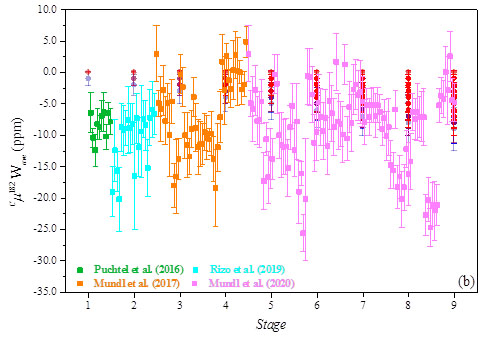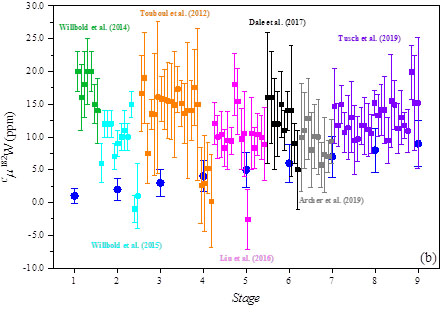Chemical geodynamics works always assume that isotope anomalies of radiogenic isotopes observed in mantle-derived samples are mainly caused by radioactive decay of reservoirs with different parent-daughter ratios after correcting natural and instrumental mass-dependent fractionations (MDF), which denies the possibility of mass-independent fractionations (MIF) under mantle temperatures.
However, the nuclear field shift effect (NFSE), also known as the nuclear volume effect (NVE), has proved to be capable of producing MIF especially for heavy metal isotope systems even under very high temperatures.
Therefore, whether such NFSE-induced MIF can contribute to some observed isotope anomalies becomes the main focus of the study.
PhD candidate ZHANG Yining and his advisor LIU Yun of the Institute of Geochemistry, Chinese Academy of Sciences (IGCAS) designed a multistage closed-system melting and crystallization evolution model (called MC2-model. Fig.1), and combined ab-initio calculations and Monte Carlo simulations to trace the variations of such small NFSE-induced MIF during multi-stage melting and crystallization processes.
Multi-stage melting and crystallization processes could occur under various geological settings, such as melting of a previously depleted mantle source or recycled subduction materials, multi-stage melting of certain lithosphere or lithospheric mantle, multi-stage reworking of previously formed crust, multi-stage melting and extraction of a plume and its surrounding mantle, and the potential “heat-pipe” tectonics involving mass volcanic processes and continuous replacement of lithospheric materials.
Based on the simulation results, the researchers discovered an amplification effect during such multi-stage evolution process with a precondition of tiny but relatively consistent enrichment or depletion of isotopes exist between two phases.
Due to such amplification, isotope fractionations would be scaled as aN, where N was the total number of melting or crystallization processes and a was a factor that related to the evolution path and detailed melting or crystallization behaviors, such as partition coefficient (D) and the degree of melting or crystallization (F). It meant that if a mantle source region experienced multi-stage melting and crystallization processes, tiny MIF signals would probably be linearly magnified. Taking O and W isotopes as examples, the researchers conducted a statistical analysis for the results of such multi-stage simulation experiments, and concluded that some of the ppm-level 182W anomalies, both positive (Fig. 2) and negative (Fig. 3) observed in Archean mantle-derived and modern plume-derived samples might be explained by this way, but this was not the case for 17O anomalies observed in anorthosite and basalts (Fig. 4).
This study explored a different perspective for the origin of isotope anomalies observed in mantle-derived samples, and was published in Geochimica et Cosmochimica Acta.
|

|
|
Fig. 1 Structure of MC2-model. (Image by IGCAS)
|
|

|
|
Fig. 2 Calculated μ182W anomalies of residue silicate phases in ppm with186W/184W being fixed for a 9-stage silicate-metal segregation MC2 simulation based on an average ~0.01 ‰ enrichment of186W/184Wratio in the metal and compared with the observed data for mantle-derived samples. (Image by IGCAS)
|
|

|
|
Fig. 3 Calculated μ182W anomalies of residue silicate phases in ppm with186W/184W being fixed for a 9-stage metal free silicate differentiation MC2 simulation based on an average ~0.01 ‰ enrichment of186W/184Wratio in the metal and compared with the observed data formantle-derived samples. (Image by IGCAS)
|
|

|
|
Fig. 4 Calculated Δ’17O anomalies (red: melt; blue: solid) for a 9-stage MC2 simulation based on an average ~0.1 ‰ enrichment of18O/16O ratio in the melt and compared with previously observed data for mantle-derived samples. (Image by IGCAS) |
Contact:
LIU Yun
Institute of Geochemistry, Chinese Academy of Sciences
Email: liuyun@vip.gyig.ac.cn
(By Prof. LIU Yun's group)